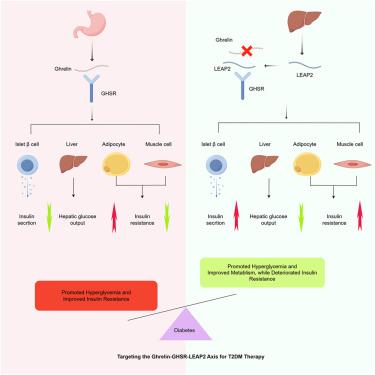Ghrelin-GHSR-LEAP2 system in the pathophysiology of type 2 diabetes
IF 4.1
2区 综合性期刊
Q1 MULTIDISCIPLINARY SCIENCES
引用次数: 0
Abstract
The Ghrelin-GHSR-LEAP2 system plays a multifaceted role in the pathophysiology of type 2 diabetes mellitus (T2DM). Ghrelin, through the activation of its receptor GHS-R1a, contributes to hyperglycemia by suppressing insulin secretion, inducing insulin resistance, and promoting hepatic glucose production. In contrast, LEAP2, an endogenous antagonist and inverse agonist of GHS-R1a, mitigates these effects by enhancing insulin secretion and improving glucose tolerance. Notably, ghrelin also demonstrates protective properties against diabetic complications through anti-inflammatory, antioxidant, and anti-apoptotic mechanisms. This duality highlights the complexity of the therapeutic targeting of the ghrelin-GHSR axis. This review provides an updated overview of the molecular mechanisms and physiological functions of the ghrelin-GHSR-LEAP2 system in T2DM and discusses the therapeutic potential and challenges of modulating this pathway.

Ghrelin-GHSR-LEAP2系统在2型糖尿病病理生理中的作用
Ghrelin-GHSR-LEAP2系统在2型糖尿病(T2DM)的病理生理中起着多方面的作用。Ghrelin通过激活其受体GHS-R1a,抑制胰岛素分泌,诱导胰岛素抵抗,促进肝脏葡萄糖生成,从而导致高血糖。相比之下,GHS-R1a的内源性拮抗剂和逆激动剂LEAP2通过增强胰岛素分泌和改善葡萄糖耐量来减轻这些影响。值得注意的是,胃饥饿素还通过抗炎、抗氧化和抗凋亡机制显示出对糖尿病并发症的保护作用。这种双重性突出了ghrelin-GHSR轴治疗靶向的复杂性。本文综述了ghrelin-GHSR-LEAP2系统在T2DM中的分子机制和生理功能,并讨论了调节该通路的治疗潜力和挑战。
本文章由计算机程序翻译,如有差异,请以英文原文为准。
求助全文
约1分钟内获得全文
求助全文
来源期刊

iScience
Multidisciplinary-Multidisciplinary
CiteScore
7.20
自引率
1.70%
发文量
1972
审稿时长
6 weeks
期刊介绍:
Science has many big remaining questions. To address them, we will need to work collaboratively and across disciplines. The goal of iScience is to help fuel that type of interdisciplinary thinking. iScience is a new open-access journal from Cell Press that provides a platform for original research in the life, physical, and earth sciences. The primary criterion for publication in iScience is a significant contribution to a relevant field combined with robust results and underlying methodology. The advances appearing in iScience include both fundamental and applied investigations across this interdisciplinary range of topic areas. To support transparency in scientific investigation, we are happy to consider replication studies and papers that describe negative results.
We know you want your work to be published quickly and to be widely visible within your community and beyond. With the strong international reputation of Cell Press behind it, publication in iScience will help your work garner the attention and recognition it merits. Like all Cell Press journals, iScience prioritizes rapid publication. Our editorial team pays special attention to high-quality author service and to efficient, clear-cut decisions based on the information available within the manuscript. iScience taps into the expertise across Cell Press journals and selected partners to inform our editorial decisions and help publish your science in a timely and seamless way.
 求助内容:
求助内容: 应助结果提醒方式:
应助结果提醒方式:


